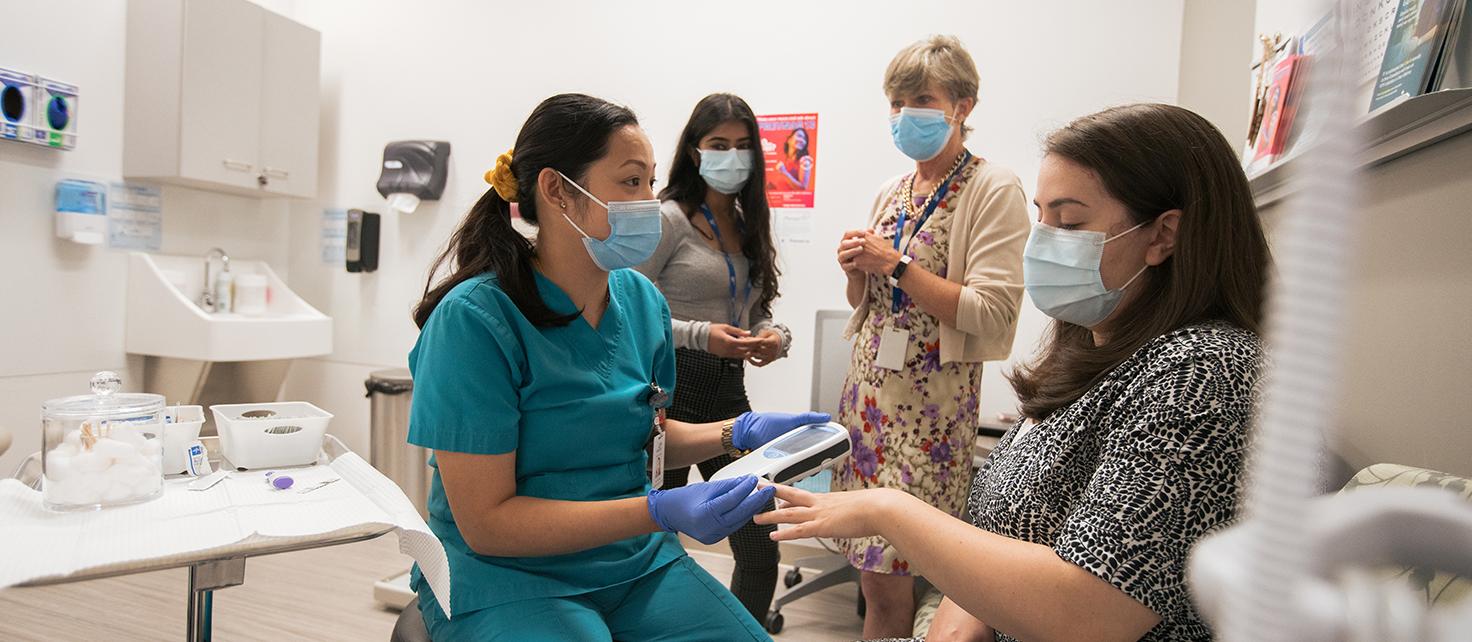Primary care pharmacist and preceptor Heather Hadden works with 2T2 PharmD student Sonia Gupta and registered practical nurse Tatyana Arleta
Maeryl Sumagang’s primary care APPE rotation provided experience in collaborative patient care
Pharmacy students interested in direct patient care might typically consider career paths in community or hospital pharmacy. But another route – primary care pharmacy – is a different way to care for patients, working within a health care setting such as a family health team or community access centre.
A rotation in primary care caught Maeryl Sumagang’s attention when she was looking at her options for her advanced pharmacy practice experience (APPE) in her final year of the PharmD degree.
“I’m really interested in direct patient care. I think that’s where I really excel and what I find most meaningful,” she says. “I was very interested in getting experience in primary care because it’s a different type of environment to practice in that allows us to utilize our scope of practice in a unique way, and I knew I wanted to have this experience before leaving school.”
In May 2021, she started her first APPE rotation at CarePoint Health, an interprofessional health team in Mississauga, under the supervision of her preceptor, Heather Hadden. CarePoint Health includes three full time pharmacists, as well as dieticians, social workers, nurse practitioners, psychologists and other health care professionals, all of which work together to support approximately 70 physicians in Peel Region.
“The culture in primary care is one of teamwork and collaboration, and I really enjoyed that”
“The culture in primary care is one of teamwork and collaboration, and I really enjoyed that,” says Sumagang. “This practice site, and primary care in general, includes a lot of collaboration with other members of the patient’s circle of care –not only their family doctor or nurse practitioner but any specialists, community pharmacist and any other health care provider.”
Primary care pharmacists often “jack of all trades”
Pharmacists were first integrated into family health teams in Ontario in 2006, with approximately 200 pharmacists now working in a primary care setting in the province. These pharmacists are embedded within interdisciplinary health care teams to provide comprehensive pharmacy services to physicians and patients.
Different from a community pharmacist, primary care pharmacists provide services to patients and physicians through the health team or centre (rather than a pharmacy). These services include comprehensive medication reviews for patients on multiple medications, providing drug information and education to the other health care professionals on the team and patients, and working with the patient’s community pharmacist on their prescriptions.
The number of pharmacists working in primary care has grown in recent years, but rotations in these settings are not yet as common as other direct patient care settings. These in-demand rotations allow students to see a different scope of pharmacy practice from both community and hospital settings.
Heather Hadden (8T4) has been working as a primary care pharmacist for more than 13 years and has supervised a number of learners during that time.
“You have to be a jack of all trades,” says Hadden. “Students who really excel have a huge knowledge base and are very good communicators, and they have the confidence to speak with physicians and know that their knowledge is valid.”
2T2 PharmD student Maeryl Sumagang
Primary care rotation provides learnings that can apply in any setting
Sumagang says that, throughout her ten-week rotation, she was able to gain valuable experience in caring directly for patients and in providing the different pharmacy services offered at the practice site. Much of the day-to-day work with Hadden was helping patients manage medications, including identifying drug therapy problems and making medication recommendations to prescribers. But she was also involved in taking medication histories, educating patients on how to use properly use their medications, and conducting literature searches to answer drug-related questions from health professionals and patients.
Being part of an interprofessional health care team that all work together to provide comprehensive patient care also allowed Sumagang to learn about other health care disciplines and community services that she could refer patients to in any pharmacy practice setting.
After the primary care rotation finished in August, Sumagang completed a clinical rotation at Headwaters Health Care Centre in Orangeville, Ontario, and recently started her next one at the Hospital for Sick Children. She says that her experience in primary care will be helpful in any setting.
“We saw a number of complex patients with a lot of drug therapy problems, and I learned a lot of ways that we can help them. As a pharmacist, you’re well suited to provide a wide range of patient care services in a primary care setting,” she says. “I gained a lot of knowledge and skills in working with complex patients that will be helpful, not just in my rotations but also in my future practice.”
More News
Image

Faces of PharmSci: Kristy Scarfone
Co-supervised by Professor Jillian Kohler and Assistant Professor Jaris Swidrovich, MSc student Kristy Scarfone is researching how unregulated substance-related care and harm reduction vary across Ontario, with the goal of strengthening public health and showcasing pharmacists’ impact in this area.
Read More
Image

Research team aims to co-design diabetes and dementia support programs that meet community needs
Network for Health Populations funding will support collaborative project to improve health outcomes for immigrant communities in Mississauga.
Read More
Image

Pharmaceutical industry resident finds growth in new challenges
Pharmaceutical Industry Residency Program Award recipient AnnaMaria Passas gained new skills through residency and research project to improve marketability in industry.
Read More

